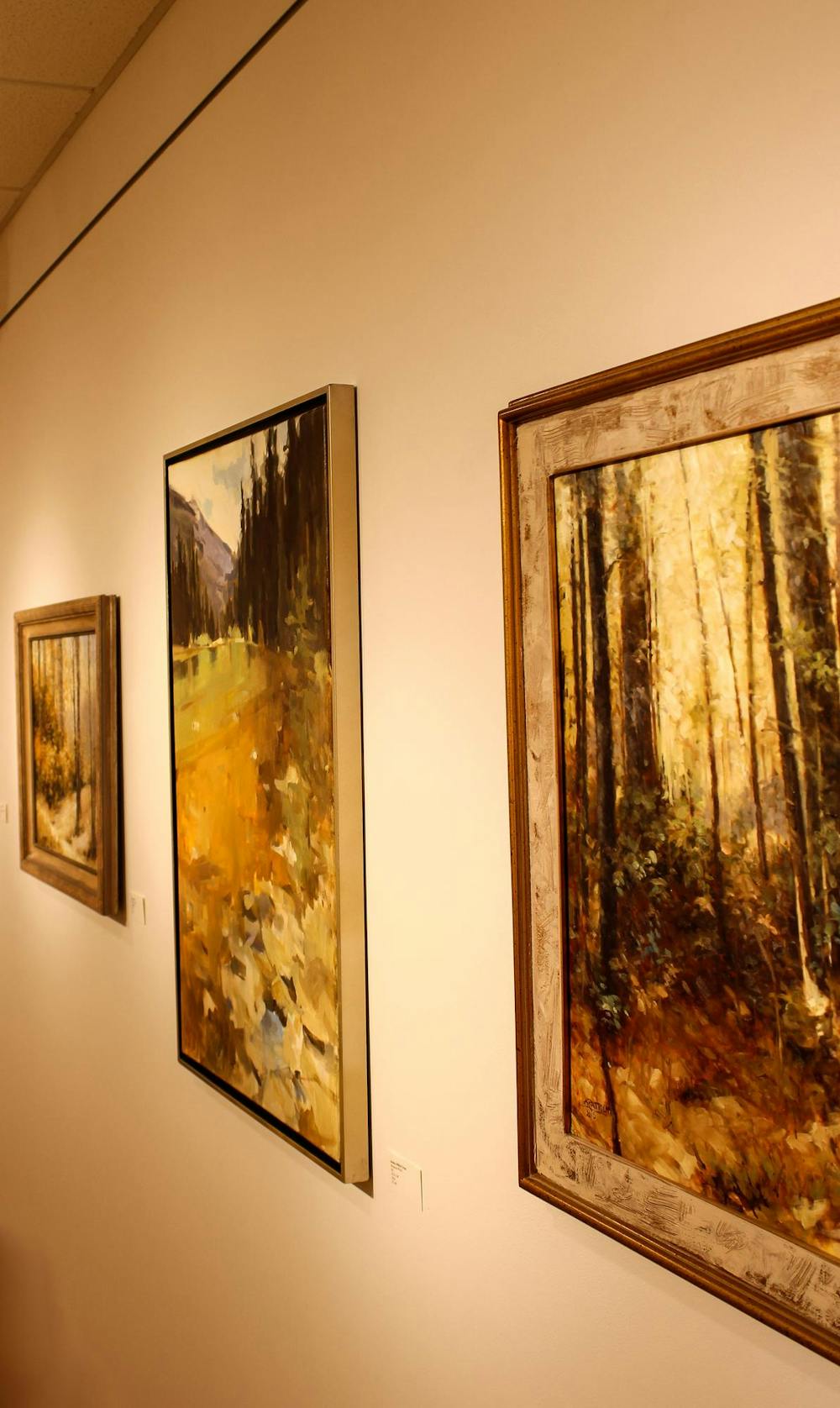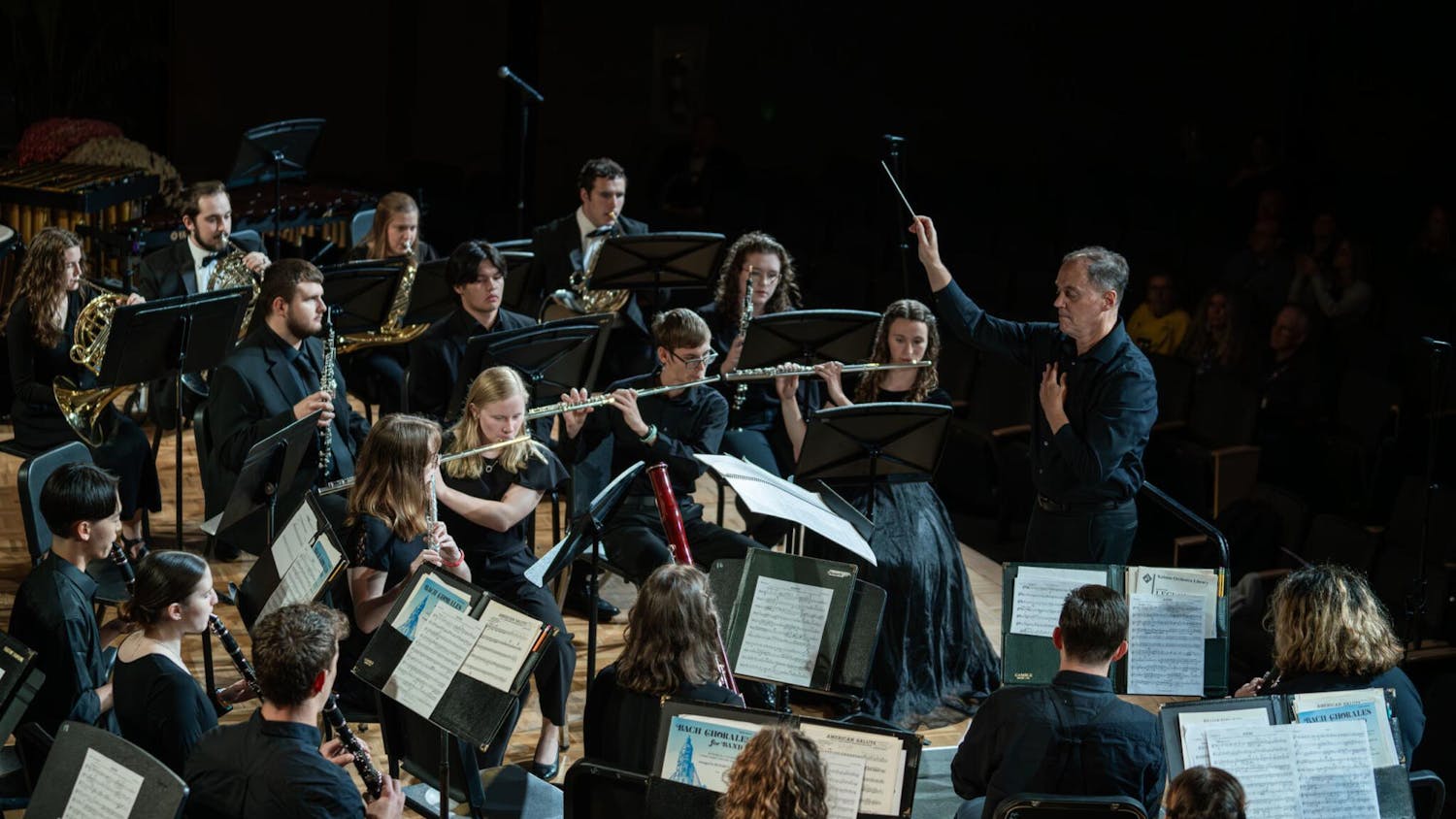Myriads of impressionistic outdoor paintings and vivid modern images hung on the walls, while eclectic structures were interspersed throughout Metcalf Gallery.
The Metcalf Visual Arts Center hosted the opening of the “Out of Indiana” art exhibition on Oct. 25. Jeremie Riggleman, an assistant professor of art, first reached out to artists in August of 2024 with a goal to curate an art collection inspired by the previous fall semester “Out of Indiana: Clay Invitational.”
“Since that was focused on clay, we decided to just open it up to any medium,” Riggleman said. “(The goal was) for people to see that there are folks not very far away that are making work like this, because you don't have to live in New York or Chicago or LA to make work as an artist.”
The end results displayed a sharp contrast of styles from 12 different artists.
On a pedestal in the center of Metcalf Gallery were nail clippings in a vial and a pottery stone with the words, “You say ‘witch’ like it’s a bad thing.” Across from these objects were a collection of oil paintings in golden frames—from brushstrokes of sunlight in a Michigan forest by Alan Patrick to crimson-blushing roses by Jessica Green.
One particular genre of items that Riggleman said he picked out was abstract art. He was drawn to particular drawings, paintings and objects that would encourage the Taylor students who work on abstract creations or have the potential to create them in the future.
3D imagery made its way onto the scene in four encaustic collages made by Elizabeth Guipe Hall, an artist featured at The Harrison Center in Indianapolis.
The art pieces all have a theme of wayfinding or personal mapmaking, she said. The collages featured mostly pastel colors and highlighted symmetrical and asymmetrical shapes with occasional metallic dots and smears.
“There's no narrative in it at all, except whatever's in (people’s) heads, because it doesn't matter if people get what I think it is; it's what they think it is,” Hall said. “Now you bring your own experience (to) every image or every object that you ever look at, and so no two people can look at things the same way.”
Hall has used different mediums to explore various themes—from Japanese art’s controlled and refined aesthetic to autobiographical elements like photos of her grandparents doing mission work in India.
Her approach to creating an original collage began with damar resin, pigment and paper in some type of form. As each layer is put down, it is fused to the prior one with heat—something that Hall uses anything from a heat gun to a propane torch to do.
Hall said she hopes that viewers of the exhibition will be able to connect on an emotional level with her work, whether they find a piece calming or energizing.
“I find geometry extremely beautiful because you find it everywhere,” Hall said. “You find it in nature, you find it in the man-made world—and it’s calming, and it’s something that's knowable and it's comforting.”
For Sandra Gaier, an adjunct art professor at Ball State University, art is something that can be gathered from common, domestic materials.
“I have bags and bags and bags of all the weird stuff that I've collected at my home that I'm like, ‘Oh, I'll stick this in something,’” she said. “I'll have a weird bag of horsehair and a weird bag of nail clippings and candy wrappers.”
Gaier has four pieces of work displayed: a nail care chatelaine, a brooch and two different pieces of work that have intertwined wisps of horsehair and wrapped metal.
For over 20 years, she has been creating art and began metalworking when she was in eighth grade. Her work is inspired by simple and daily tasks that aren’t recognized as often as others.
“My hope is to sort of elevate it, almost (to a) reliquary-esque,” she said.
She first became interested in chatelaines as a historical form of jewelry due to their associations with access, power and authority. The set of short chains would often hold keys to a castle, giving the woman in charge access to every room.
The chatelaine put a humorous twist on that idea by replacing keys with a nail cutter holder and glass vial filled with nail trimmings. Gaier was inspired by the mundane aspect of cutting her children’s fingernails and being able to keep that moment frozen in time.
In the far corner of the room are two abstract paintings by Andrée Leduc with shades of blues, pinks, yellows and mossy greens. One frame had a white line with acute angles running through it, while ocean wave marks appear to swell above. The other frame revealed an imprint of a reaching hand and falling objects.
Riggleman said that the pencil or charcoal mark-making on the canvases invoked his curiosity. Even though he has not dabbled in that type of artistry in 30 years, he said it has awoken a renewed spark in him.
“I feel like the artist was so free to do what they wanted to do,” Riggleman said. “It feels to me when I see a painting like that or like this—it feels like freedom, and I don't know, I just love it.”





